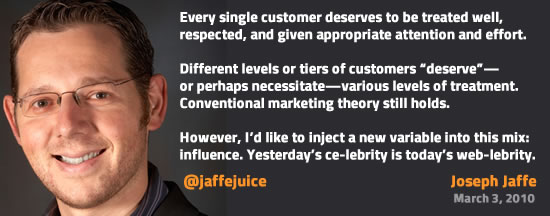Last week I sat down with Joseph Jaffe at the Deep-C event, organized by MSN Belgium. A conversation with Jaffe, author of “Life After the 30-Second Spot”.
For the early digital marketers among us, Joseph’s book is probably not really an eye-opener. But it sure was for many attending marketers and advertisers, still exploring the new digital reality and ongoing evolutions. For them, Joseph’s book is not only an eye-opener but also a wake-up-call.
Jaffe succeeded in bringing his message in a relevant, succinct and energetic way. That energy also could be felt during his keynote presentation and the talk we had afterwards.

About reach and mass media
So, what is that “message”, Jaffe wants to evangelize? It’s not that the 30-second spot is really dead but that it had its’ best days. The supremacy of TV commercials and TV as a medium can’t be justified anymore in a world where the consumer disposes of more devices and media than ever before and, on top of that, has more control.
The old adage of ‘reach’ through the mass medium TV and its’ famous 30-second format are not adapted for these changing times. They also miss a large part of their target audience. As Jaffe says: it’s time to break through the clutter and get the attention. One might even add that it’s time to deserve the attention.
TV commercials are poorly targeted, Jaffe continues. As he asked the audience at the Deep-C event: “how many men here feel attracted by commercials for sanitary towels”? To make things worse, Joseph says, in the last decennia there has been an absolute creative standstill in the 30-second spots. The result? Jaffe: “people don’t buy it anymore”.
On a side note he adds that the daily reach of the average online portal nowadays is far higher than that of a top TV show (do bear in mind the event was organized by MSN).
New marketing: from crayons to user-generated content
It’s time for “new marketing”, Joseph continues. Then what is this “new marketing”?
If you’re deep into digital marketing already, you can guess. But there’s more. Let’s start by saying what this “new marketing” is not: following the well-trodden paths, even if they’re digital or interactive.
Just one example: Jaffe is not a big fan of viral interactive marketing. “Viral marketing is for lazy marketers”, he says. “Not that there is anything wrong with viral marketing as such, it just shouldn’t be an end goal”, he continues.
If your “new marketing” efforts are good and happen to and through your communities and audiences, they will automatically go viral, Jaffe says. Or in other words: make it relevant, customer-centric and connected, understanding and involving communities.
To illustrate what “new marketing” is, Joseph likes to use the image of a box of color crayons. While “old marketing” only used the main colors, today we have a richer box with far more colors, opportunities to combine colors and new textures. It’s the combination of all the new possibilities we have that matters. Integrating and connecting with the consumer in mind.
Some examples: search, blogs, podcasts, online ads but also DVDs, games, mobile applications and – when you involve communities – user-generated content. The advent of ever more media, devices or crayons as Jaffe calls them, and the evolving media consumption and buying patterns, require brands and marketers to evolve as well.
Or in other words: today’s marketer will not be able to keep using that basic colors he or she has been using forever. Evolution matters.
Change management
So, learning and experimentation are a must. But most of all, change management becomes a necessity. Marketing will not become easier but if you don’t evolve, you’ll miss the boat. The same goes for the advertising and marketing industry with all the different intermediaries as we know them today. And for the shifting powers in that market. That’s of course not easy in a world where the majority of budgets keeps going to those famous TV commercials. Dinosaurs will continue to try and cling to media power and budgets. But, in the end, dinosaurs die too.
Radical changes ahead. However, what are these radical changes exactly?
Joseph Jaffe: the old process of informing, persuading, reminding and keeping reminding until the consumer gives up after being swamped by the never-ending cannon shots of the advertiser, is over.
In his book Joseph offers three alternatives:
- involve (the consumer)
- empower (the consumer)
- demonstrate
The latter can be interpreted quite literally. Done with clearly misleading commercials that reduce the consumer to an idiot and promise him a better life when buying product xyz. No, brands will also have to demonstrate it, among others with useful content and using the other mentioned “alternatives”: involving and empowering.
And Joseph has two more alternatives for us:
- activate
- express
Ivory towers and the power of a consumer with a blog

The message Joseph Jaffe presented is crystal clear and should be known by digital marketers at the very least by now. If you don’t take the increasing freedom of choice and involvement of the consumer and the growing number of touchpoints and potential contact moments, as enabled by new digital devices, to build a more personal relationship and way of communicating, into account, you keep firing a mosquito with a cannon, as the Dutch expression goes.
If you don’t get more close and personal with consumers in your branding activities as well, you’ll alienate even more from your consumers and keep living in ivory towers. In this regard, Jaffe reminds us how the consumer starts punishing brands displaying such a mentality and mentions several examples of how people, just using a blog, damaged the reputation of arrogant and alienated brands that weren’t listening to them.
The book “Life After the 30-Second Spot: Energize Your Brand With a Bold Mix of Alternatives to Traditional Advertising ” by Joseph Jaffe is published by Wiley and now available.
It’s a must-read for execs since, as Jaffe replies when asking him about the changing relationships between the advertiser and the agency: “they are both responsible to make it happen but, no matter how you turn it, change comes from the top”.
Originally posted on Marketing Advisor on November 29th, 2005, and moved as part of an integration.

